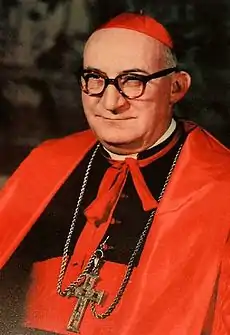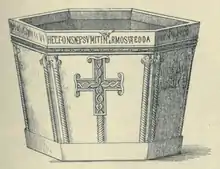His Eminence Franjo Šeper | |
|---|---|
| CardinalPrefect of the Congregation for the Doctrine of the FaithArchbishop of Zagreb | |
 | |
| Church | Roman Catholic |
| Archdiocese | Zagreb |
| Appointed | 8 January 1968 |
| Term ended | 25 November 1981 |
| Predecessor | Alojzije Stepinac |
| Successor | Franjo Kuharić |
| Other post(s) | Cardinal-Priest of SS Pietro e Paolo a Via Ostiense |
| Orders | |
| Ordination | 26 October 1930 by Giuseppe Palica |
| Consecration | 21 September 1954 by Josip Ujčić |
| Created cardinal | 22 February 1965 |
| Rank | Cardinal-Priest |
| Personal details | |
| Born | 2 October 1905 |
| Died | 30 December 1981 (aged 76) Rome, Italy |
| Nationality | Croatian (Yugoslavian) |
| Previous post(s) |
|
| Coat of arms |  |
| Part of a series on the |
| Catholic Church in Croatia |
|---|
 |
Franjo Šeper (2 October 1905 – 30 December 1981) was a Croatian prelate of the Catholic Church. He served as prefect of the Congregation for the Doctrine of the Faith from 1968 to 1981, and was elevated to the cardinalate in 1965. Before that, he served as the Archbishop of Zagreb from 1960 to 1969.
Biography
Born in Osijek, in the Austro-Hungarian Kingdom of Croatia-Slavonia (present-day Croatia), he and his family moved to Zagreb in 1910; his father was a tailor and his mother a seamstress. He started his seminary studies in Zagreb then at the Pontifical Gregorian University) in Rome. He was ordained to the priesthood by Archbishop Giuseppe Palica on 26 October 1930.
His first pastoral assignments were in the Archdiocese of Zagreb and, in 1934, was appointed private secretary to the Archbishop. In 1941, father Šeper became the rector of the archdiocesan seminary, a post which he held for the next decade. On 22 July 1954 he was named Coadjutor Archbishop of Zagreb and Titular Archbishop of Philippopolis; he received his episcopal consecration on the following 21 September from Archbishop Josip Ujčić of Belgrade.
He succeeded Cardinal Aloysius Stepinac as Archbishop of Zagreb on 5 March 1960, and was created Cardinal-Priest of Ss. Pietro e Paolo a Via Ostiense by Pope Paul VI in the consistory of 22 February 1965.
Prefect of the Congregation of the Doctrine of the Faith
He was named Prefect of the Congregation for the Doctrine of the Faith (CDF) on 8 January 1968. Šeper was also the President of the International Theological Commission from its inception in April 1969, and the author of the 1973 document Mysterium Ecclesiae,[1] which was written in order to re-orient the ecclesiology of the post-Vatican II period.
After the first meeting held on 11 April 1969 in the convent of the Divine Master in Ariccia, in the Vatican he supervised the development of work on the ecumenical dialogue between the Church and Freemasonry.[2]
In 1974, the Congregation published a "Declaration on procured abortion", re-asserting the Church's opposition to the procedure since the publication of Humanae Vitae. It later published the document Persona Humana[3] on the topic of sexual ethics.
In 1976, he was responsible for writing the statement Inter Insigniores, which firmly rejected the ordination of women in the Catholic Church. Inter Insigniores does not apply to the question of ordaining women as deacons in the Catholic Churches. In 1980, he also wrote the CDF's declaration on Euthanasia, explaining the Church's view on ending life.
Šeper was a cardinal elector in the August and October conclaves of 1978.
Death and legacy
Pope John Paul II accepted Šeper's resignation as Prefect on 25 November 1981. He died on 30 December in Gemelli Hospital, where he had been hospitalized for a month.[4] John Paul presided at his funeral Mass, and Šeper's body was later transferred to Zagreb, where it is buried beside the tomb of Cardinal Stepinac.
References
- ↑ Sacred Congregation of the Doctrine of the Faith, Declaration in Defense of the Catholic Doctrine on the Church against certain errors of the present day, published 24 June 1973, accessed 16 November 2021
- ↑ Sandro Magister (19 August 1999). "Tra il papa e il massone non c'è comunione". L'Espresso.
- ↑ Persona Humana, vatican.va; accessed 18 March 2016.
- ↑ "Cardinal Seper Dies in Rome; Vatican Guardian of the Faith". The New York Times. 31 December 1981. Retrieved 8 August 2017.
External links
- Michael Davies's account of his 1980 meeting with Šeper
- Audio recordings with Franjo Šeper in the Online Archive of the Österreichische Mediathek. Interviews (in German). Retrieved 2. March 2020
